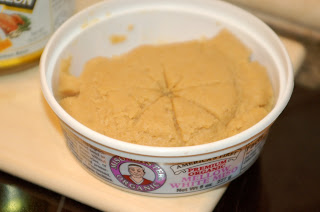 |
| Make your own all purpose, gluten free (AP GF) flour mix! Store in a glass, airtight container for best results. |
 |
| Gluten free cupcakes, Yummo! |
Where are my manners? All this writing and recipes about GLUTEN FREE, yet not any recipes on how to make one's own gluten free all-purpose flour mix to use when recipes call for it! Here are a few options that I have used and enjoyed. Use these mixes as you would use your white/wheat based flour recipes. Use 1 for 1. If you've never tried gluten free baking or cooking, don't be afraid. Yes, it is a slightly different texture with some recipes. Yes, it will bake longer or shorter some times. Yes, your cookie may even be shaped differently. I won't lie, some recipes should not be made gluten free. I have tried the gluten free breads, and they can be a challenge, but I have made some darn good GF cinnamon buns! GF cut-out cookies were tedious, fyi. If anyone has mastered this I would love to know your secret. Don't use only one type of flour for GF baking because it WILL disappoint you. There is a science behind the mixing of the flours, trust me on this. Stick with one of these combos and you'll be fine!
I always make huge batches at one time (and freeze some if I have too much). So double, triple, whatever you want when making your GF flour mix.
Gluten Free All-Purpose Flour Mix # 1:
1 cup of sorghum flour or brown rice flour
1/2 cup of millet or buckwheat flour (also can use almond meal, it's just more expensive, although super healthy!)
1 cup tapioca, potato starch (not potato flour) or corn starch (not corn flour)
1 tsp. xanthan gum
*Best mix for using with breads, muffins, cookies, and cakes
Gluten Free All-Purpose Flour Mix # 2:
1 cup of sorghum flour or brown rice flour
1/2 cup of millet flour
1/2 cup of buckwheat flour
1/4 cup quinoa or almond flour
3/4 cup potato starch, (not potato flour) tapioca starch or corn starch (not corn flour)
1 tsp xanthan gum
*This is best used for dense breakfast muffins, cookie bars and bread
You will need to mix your flours very well, I use a fork or a whisk to do this. Also, be precise in your measuring. Store in a glass, air tight container, away from heat or moisture sources.
 |
| Use the back of a knife, or any flat utensil (this is a frosting spatula) to properly measure by taking the mound off the top of your measurement of each flour |
The Gluten Free Goddess has a TON of recipes and information for those ready for in depth baking and learning.
For newbies, I suggest starting with a pre-mixed store bought all-purpose gluten free mix, like PAMELA's Ultimate Baking and Pancake Mix. If you find you're gaining confidence, then try the mixes above, as it is more economical to make your own mix. Pamela's also makes an AMAZING chocolate cake GF mix. Truly, nobody will know the difference!
 |
| I found it on sale at Wal Mart!!! |
 |
| these turned into........... |
 | |
| .......these! Who knew the martians could taste so good without gluten? |
Suggestions and "Good to Know":
1. Buy your GF flours in bulk when possible (or larger bags)
2. Buy organic GF flours when possible
3. Make your own almond meal (if you have a Blendtec, Vitamix, grain mill, or something powerful like these to make fine almond meal flour with almonds- buy almonds in bulk, organic if possible)
4. The starches have almost no fiber or nutrition (they are strictly there to help incorporate and bond the flour when used in recipes)
5. Most GF flours have way more fiber than white flour. White rice flour is low on the scale of fiber at 1 gram and brown rice flour comes in at 2 grams per 1/4 cup serving size. Quinoa has 2 grams, sorghum has 3 grams, millet has 3 grams, buckwheat has 6 grams, all at 1/4 cup serving size. Coconut Flour (not mentioned in above mix recipes, see why I don't use it in the GF AP mix in explanation below) has 6 grams of fiber for ONLY 2 Tbsp serving size!!
6. Recommended brands of gluten free flours: Bob's Red Mill (organic when possible) and Arrowhead Mills, I can find these almost anywhere, so I am confident you can as well. If not, look at Vitacost.com.
7. Don't freak out when you see how much xanthan gum costs. You will only use it in very small doses and it is a must!
 |
| This brand will probably look familiar to you! |
I absolutely adore coconut anything, however, when baking with coconut flour, it is important to remember that it is HIGH in fiber, therefore VERY drying. It absorbs moisture like a sponge. It can suck the life out of your cookies or muffins leaving them crumbly and not so yummy. So, I use it sparingly in recipes, never as a 1 for 1 substitute for white or wheat flours. I will throw in a tablespoon here or there if I want to make a GF batter recipe more stable and thick. Remember, 1 tablespoon is equal to 3 grams of fiber. That is excellent stuff!
Happy baking and cooking to all you gluten free buddies!



















































